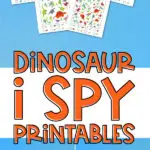I Spy printables for kids are not only fun for young kids but they actually set them up for success in the classroom and in life!
It is amazing to see all the ways these simple worksheets can help children develop necessary skills.
See some of the wonderful benefits of using them below!

This post may contain affiliate links. As an Amazon Associate and a participant in other affiliate programs, I earn a commission on qualifying purchases. Read our disclosure policy.
Improving Visual Discrimination Skills
Visual Discrimination is the ability to identify similarities and differences using the sense of sight.
It is a crucial early reading and math skill. Recognizing visual details from an I Spy worksheet helps build that skill so that as they grow, children can begin to discriminate between shapes, colors, letters, and numerals.
Visual discrimination is essential to learn the letters of the alphabet, to recognize numbers and later, to read sight words.
Without visual discrimination skills, it would be nearly impossible to differentiate between similar figures such as b, d, p, and q, or 3 and 8, 4 and H, and so on.
Using I Spy printables can encourage the practice of a child’s visual discrimination skills. They must examine each picture and mentally match the item in shape, size, texture, color, and other variables.
Other ideas for building visual discrimination skills: memory games, hidden pictures, and sorting activities.
Improving Working Memory Skills
Not only do I Spy activities improve visual discrimination skills, they also build a child’s working memory. Working memory is the information held in the mind at any moment.
It’s how adults can remember a short list at the grocery store, a phone number, and remember all the moves to the latest dance craze. It’s having the ability to retain information long enough to do something with it.
Having a strong working memory is what helps a child learn new skills and tasks. Children that have strong working memories can:
- Stay focused and on task
- Use previously learned information in new situations
- Follow complex or multi-step directions
Younger children have less working memory skills.
It’s best with very young learners to use simple or one step directions, simple vocabulary, and visual reminders.
Using I Spy activities also helps strengthen that working memory. The child must find an object, say, a teddy bear.
While looking at the picture, they identify each item as they see it – “There’s a book, there’s a stuffed giraffe, there’s a blanket” – and sift through that information until they find the object they are looking for.
That requires them to hold the idea of “teddy bear” in their mind despite the distraction of the other images their eyes are processing.
The longer the list or more complex the picture, the more difficult it is.
Other ideas for building working memory skills: Games like SIMON, What’s Missing, copying rhythms one beat at a time, adding on to list games like Chip Chop, Chippity Chop, Memory, and similar games.
Encouraging Focus on Reading
Children who are engaged learn more quickly and have better retention.
Some activities, like playing in a sensory tub or building with blocks, are naturally engaging.
Reading and writing sometimes are a little tricky, because it means a child must stay in one area and focus.
I Spy activities and books help engage the child and encourage them to stay with the materials longer, which then translates to better focus in similar skills such as writing their name or taking their time with a book instead of hurrying through the pages.
All of these things are great reasons to let your child use I Spy printables!
Download any of these I Spy printables, laminate them and let your child use a dry erase marker to play over and over again!
More Fun Activities For Kids

Sam is the crafter and founder of Simple Everyday Mom. She has been featured in Oprah Mag, Good Housekeeping, The Spruce Crafts, Country Living, The Bump and more. Read more.




